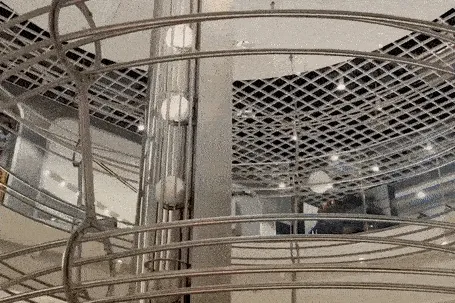This story is the first installment of our series about the state of store design today.
Walk into the Radio Flyer store, which opened in the Woodfield Mall outside Chicago in November, and it’s one of the first things you notice: parked on a bright green circle of astroturf is one of the brand’s signature red wagons, except this one is much bigger, with wheels the size of a sedan’s.
“It’s like Honey, I Shrunk the Kids,” Robert Pasin, who instead of CEO, calls himself the Chief Wagon Officer of the company, told Retail Brew.
Lori Mukoyama, a principal at Gensler who worked on the store’s design, climbed into the cart for a photo she posted to her Instagram account.
“I’m sitting in this huge wagon, but it automatically makes you feel like even as a full-grown adult, I’m kid-sized again,” Mukoyama told Retail Brew.
Lori Mukoyama/Gensler
“It brings the child out in adults,” Pasin said. “They start laughing, they start smiling.”
It’s the first store for Radio Flyer, founded by Pasin’s grandfather, Antonio, in 1917. But it’s more than just a milestone. While widespread store closings in recent years gave rise to the term “retail apocalypse” even before Covid-19 made online shopping more ubiquitous, the store may help mark a store-design renaissance.
Stores increasingly are creating elevated experiences where they make not just sales but also memories. Whatever you call it—retailtainment, experiential marketing, or brand storytelling—retailers are connecting with consumers more meaningfully than they can through phone screens.
Experience required: In the Covid era, shoppers have “online shopping fatigue” and “want full-on experience,” Mukoyama said.
Radio Flyer
The Radio Flyer store’s centerpiece is a large track for test-driving its range of products, which includes bikes, scooters, go-karts, and even a kid-sized Tesla Model S electric car that retails for $500.
Mukoyama said the track engenders a sense of community inside the store as parents watch their pedaling progeny.
“So I might be there with my 5-year-old and then someone else might be there with their 5-year-old too,” Mukoyama said. “And suddenly we’re chitchatting because our kids are riding their bikes around. So it also is helping bring people back together where it’s your local park or your local coffee shop.”
Radio Flyer
Not everyone thought that putting elements of a skate park and playground into a store was a great idea.
“A lot of people were like, ‘Oh, you know, the insurance, the blah, blah, blah,” Pasin said, noting that the store requires parents to sign waivers before their kids don helmets and hit the track. “We’re in the ride-on business because these are vehicles; we’ve got to get people riding them, and they’re very safe.”
Radio Flyer
Inside track: Any store aspires to be a destination, and for Radio Flyer, it happened in one way they hadn’t planned when someone asked if they could host their kid’s birthday there. The store did its first event recently, giving the birthday kid and their friends the run of the place on a Sunday an hour before the store opened.
Retail news that keeps industry pros in the know
Retail Brew delivers the latest retail industry news and insights surrounding marketing, DTC, and e-commerce to keep leaders and decision-makers up to date.
“It worked great, and now we’re trying to figure out how we can do it and make it a repeatable thing,” Pasin said. “And hopefully, it can be a little bit of a revenue generator.”
Noticeably absent from the store are any video screens, contrary to some conventional Covid-era wisdom that stores should be more “phygital” by incorporating more aspects of online shopping that consumers like into their brick-and-mortar stores.
Mukoyama recalled Pasin suggesting that a big digital screen at the store entrance might be a good idea, but she pushed back.
“The energy and the excitement that we heard from [Pasin] didn’t come to life really with a big monitor,” Mukoyama said. “It just replicates everything you’re getting on your phone, right? Why do that again, when I can already get that at my fingertips?”
Welcome wagon: The store is not far from Radio Flyer’s headquarters in Chicago, and along with other executives, Pasin has spent a lot of time there. He wears a red t-shirt with a little red wagon on it, and a name tag, “Robert,” just like the sales associates, which is exactly what he is to customers, whom he assists and never tells he’s the grande fromage.
“I’ve had some people…say, ‘That Robert’s really nice,’” he told us. “That’s the best—that makes my day.”
But the real reason he and other executives are there is not to sell wagons, but to see the store in action, and adapt.
“When we’re in the store, we’re wearing a red t-shirt, but we’re really wearing a white lab coat,” Pasin said. “We’ve already reconfigured and moved stuff around based on traffic patterns. I mean, it’s been awesome. It’s been really fun, it’s been really creative, and we’re learning a ton.”

